In June of 1942,German operatives lurked off the east coast of USA in submarines. Under the cover of darkness, four men landed on a Long Island, NY. beach. Another four landed on Ponte Vedra Beach, near Jacksonville, Florida. They came with explosives meant to cripple US defense production and terrorize the American people. The Long Island team was spotted by a Coast Guardsman and one German ended up turning himself in and ratting the others out. They were all caught before anything happened.
Six of the eight saboteurs were executed in Washington DC for spying. The other two (who disclosed the plot to the FBI) were imprisoned.

The FBI, U-Boats, and Lucky Luciano
On June 13, 1942, under cover of darkness, four men landed on a beach near Amagansett, Long Island, NY. Four days later, another four landed on Ponte Vedra Beach, near Jacksonville, FL. They were German operatives - saboteurs - who arrived on German submarines lurking off the coast. Led by Lieutenant Walter Kappe, they came with explosives meant to cripple US defense production and terrorize the American people. They were all arrested by June 27, before performing a single act.
The men initially wore German uniforms, so they could claim to be POWs rather than spies if caught, but once onshore they buried the uniforms and explosives. The Long Island team were spotted after changing by Coast Guardsman John C. Cullen, who they attempted to bribe and then threatened. He left but reported it to the officer in charge. A party returned to the site, but the men were gone. They watched, hidden, as a U-202 surfaced and sailed away. In the morning they found German cigarettes as well as the uniforms and explosives, and they called the FBI. Each of the German operatives had spent time previously living in the US, and they intended to blend in under their assumed identities before retrieving their supplies for the mission. However, one of them, George John Dasch, decided not to go through with it.
Dasch called the FBI, first the NY office and then Headquarters in DC, where he later turned himself in. He was interrogated and gave the FBI all the information about his mission and his fellow saboteurs. Tried by a military commission, all eight were convicted, and six were executed. J. Edgar Hoover appealed to President Roosevelt to commute Dash's and Ernest Burger's sentences. Hoover had announced the story in the press, though not Dasch's confession, so the Nazis would know their plans were thwarted.
 The Nazi intelligence service did not attempt another sabotage mission in the US again. In 1944, the FBI arrested two other Germans who landed via submarine off the coast of Maine on an intelligence mission, however.
The FBI investigated many allegations of sabotage during the war. They even went so far as to strike a deal with mobster Lucky Luciano to watch for sabotage in the shipyards, especially if Italian operatives infiltrated Italian-American fisherman and dockworkers. Luciano also allegedly guaranteed no dock worker strikes during the war.
The Nazi intelligence service did not attempt another sabotage mission in the US again. In 1944, the FBI arrested two other Germans who landed via submarine off the coast of Maine on an intelligence mission, however.
The FBI investigated many allegations of sabotage during the war. They even went so far as to strike a deal with mobster Lucky Luciano to watch for sabotage in the shipyards, especially if Italian operatives infiltrated Italian-American fisherman and dockworkers. Luciano also allegedly guaranteed no dock worker strikes during the war.
When the Nazis Invaded the Hamptons
Even before the US entered World War II, German military intelligence had developed a plan to secretly infiltrate the East Coast and sabotage American war efforts.History.comOperation Pastorius
Even before the United States entered World War II, German military intelligence had developed a plan codenamed Operation Pastorius - in honor of Franz Daniel Pastorius, who in 1683 had launched the first permanent German-American settlement in Germantown, Pennsylvania, now part of Philadelphia - to secretly infiltrate the East Coast and sabotage American war efforts. Walter Kappe, a German army lieutenant who had spent several years in the United States, recruited the saboteurs, all of whom spoke fluent English and had lived in the United States for a time.The night was especially dark as U.S. Coast Guard seaman John Cullen patrolled the sand dunes of Amagansett, New York, shortly after midnight on June 13, 1942. Regulations in effect after the United States entered World War II six months earlier had already imposed blackouts on the village nestled in the Hamptons, and the thick fog that blanketed the east end of Long Island made it even more difficult for Cullen to see.
The 21-year-old "sand pounder" listened to the Atlantic Ocean lap up on the shore when the figures of four suspicious men suddenly crystallized in the fog. Of course, any men on the beach in violation of the nighttime curfew were by definition suspicious, but something was particularly odd about these men who claimed to be local fishermen who had run aground.
The group's leader, who gave his name as George John Davis, didn't seem dressed for the part in his fedora, red zippered sweater and tennis shoes. The self-proclaimed fisherman then refused to return to the nearby Coast Guard station with Cullen. Perhaps realizing that there was nothing more he could possibly do to arouse suspicion, the ringleader blurted, "Look, I wouldn't want to kill you. You don't know what this is all about." The faux fisherman pulled out a wad of bills from a tobacco pouch lodged in a pocket of his wet pants and said, "Forget about this, and I will give you some money and you can have a good time."
Cullen heard one of the men speaking in a foreign language before $260 was shoved in his hands. Unarmed and outnumbered, Cullen used his discretion and began to return to the Coast Guard station a half-mile away. Once out of eyeshot in the fog, his gait quickly sped up into a sprint.
Cullen burst into the station, awoke his colleagues and pronounced, "There are Germans on the beach!" The Coast Guardsman had indeed encountered four Nazis, but he wasn't aware that they had just come ashore in a rubber boat laden with explosives, cash and intentions of sabotage.
In June 1942, BM2/C John Cullen confronted four Nazi saboteurs on a Long Island beach. He ran back to the station and returned with several other armed Coast Guardsmen, but the Nazis were gone. They were all captured by the FBI shortly thereafter, and Cullen was awarded the Legion of Merit.
 John Cullen
John Cullen
Boatswain's Mate 2nd Class
By June 27, 1942, all eight saboteurs had been arrested without having accomplished one act of destruction. Tried before a military commission, they were found guilty. One was sentenced to life imprisonment, another to 30 years, and six received the death penalty, which was carried out within a few days.Nazi Saboteurs and George Dasch
Shortly after midnight on the morning of June 13, 1942, four men landed on a beach near Amagansett, Long Island, New York from a German submarine.They were clad in German uniforms and bringing ashore enough explosives, primers, and incendiaries to support an expected two-year career in the sabotage of American defense-related production.
On June 17, 1942, a similar group landed on Ponte Vedra Beach, near Jacksonville, Florida, equipped for a similar career in industrial disruption.
The purpose of the invasions was to strike a major blow for Germany by bringing the violence of war to our home ground through destruction of America's ability to manufacture vital equipment and supplies and transport them to the battlegrounds of Europe; to strike fear into the American civilian population; and to diminish the resolve of the United States to overcome our enemies.


The magnitude of the euphoric expectation of the Nazi war machine may be judged by the fact that, in addition to the large amount of material brought ashore by the saboteurs, they were given $175,200 in United States currency to finance their activities. On apprehension, a total of $174,588 was recovered by the FBI-the only positive accomplishment of eight trained saboteurs in those two weeks was the expenditure of $612 for clothing, meals, lodging, and travel, as well as a bribe of $260.
So shaken was the German intelligence service that no similar sabotage attempt was ever again made. The German naval high command did not again allow a valuable submarine to be risked for a sabotage mission.
History.comExecuted for Spying
During World War II, six German saboteurs who secretly entered the United States on a mission to attack its civil infrastructure are executed by the United States for spying. Two other saboteurs who disclosed the plot to the FBI and aided U.S. authorities in their manhunt for their collaborators were imprisoned.Although unaware that the FBI was looking for them, Dasch and another saboteur, Ernest Burger, decided to turn themselves in and betray their colleagues, perhaps because they feared capture was inevitable after the botched landing. On July 15, Dasch called the FBI in New York, but they failed to take his claims seriously, so he decided to travel to FBI headquarters in Washington, D.C. On July 18, the same day that a second four-man team successfully landed at Ponte Vedra Beach, Florida, Dasch turned himself in. He agreed to help the FBI capture the rest of the saboteurs.
Burger and the rest of the Long Island team were picked up by July 22, and by July 27 the whole of the Florida team was arrested. To preserve wartime secrecy, President Franklin D. Roosevelt ordered a special military tribunal consisting of seven generals to try the saboteurs. At the end of July, Dasch was sentenced to 30 years in prison, Burger was sentenced to hard labor for life, and the other six Germans were sentenced to die. The six condemned saboteurs were executed by electric chair in Washington, D.C., on August 8. In 1944, two other German spies were caught after a landing in Maine. No other instances of German sabotage within wartime America have come to light.
In 1948, Dasch and Burger were freed by order of President Harry S. Truman, and they both returned to Germany.
The operation was staged in June 1942 and was to be directed against strategic American economic targets.
- The operation was named by Admiral Wilhelm Canaris, chief of the German Abwehr, for Francis Daniel Pastorius, the organizer of the first organized settlement of Germans in America.
- The plan involved eight German saboteurs who had previously spent time in the United States.
- The plan quickly failed after two of the agents, George John Dasch and Ernest Peter Burger, defected to the Federal Bureau of Investigation shortly after being deployed, betraying the other six.
- A military tribunal – whose constitutionality was challenged to the Supreme Court in Ex parte Quirin – sentenced all eight to death later that year. President Franklin D. Roosevelt commuted the sentences of Dasch and Burger, while the other six were executed.
- In 1948, Dasch and Burger were pardoned, conditional on their permanent deportation to the American occupation zone in Germany by President Harry S. Truman.
- Sixteen other people would be charged with aiding those in charge of the operation.
The Agents
Recruited for Operation Pastorius were eight Germans who had lived in the United States. Two of them, Ernst Burger and Herbert Haupt, were American citizens. The others, George John Dasch, Edward John Kerling, Richard Quirin, Heinrich Harm Heinck, Hermann Otto Neubauer and Werner Thiel, had worked at various jobs in the United States. All eight were recruited into the Abwehr and were given three weeks of intensive sabotage training in the German High Command school on an estate at Quenzsee, near Berlin, Germany. The agents were instructed in the manufacture and use of explosives, incendiaries, primers, and various forms of mechanical, chemical and electrical delayed-timing devices. Considerable time was spent developing complete background "histories" they were to use in the United States. They were encouraged to converse in English and to read American newspapers and magazines to improve their English and familiarity with current American events and culture.The Mission
Their mission was to sabotage American economic targets: hydroelectric plants at Niagara Falls; the Aluminum Company of America's plants in Illinois, Tennessee, and New York; locks on the Ohio River, near Louisville, Kentucky; Pennsalt Chemicals (then the Pennsylvania Salt Manufacturing Company) in Cornwells Heights (Bensalem), Pennsylvania; the Pennsylvania Railroad's Horseshoe Curve, a crucial railroad pass near Altoona, Pennsylvania, as well as their repair shops at Altoona; the Pennsalt cryolite (a raw material in the production of fluorine and aluminum) plant in Philadelphia; Hell Gate Bridge in New York; and Pennsylvania Station in Newark, New Jersey. The agents were also instructed to spread a wave of terror by planting explosives on bridges, railroad stations, water facilities, public places, and Jewish-owned shops. They were given counterfeit birth certificates, Social Security cards, draft deferment cards, nearly $175,000 in American money, and driver's licenses, and put aboard two U-boats to land on the east coast of the U.S.Before the mission began it was in danger of being compromised as George Dasch, commander of the team, left confidential documents on a train, and one of the agents when drunk announced to patrons in a tavern in Paris that he was a secret agent.
On the night of 12 June 1942, the first submarine to arrive in the U.S., U-202, landed at Amagansett, New York, about 100 miles east of New York City on Long Island, at what is now Atlantic Avenue beach. It was carrying Dasch and three other saboteurs (Burger, Quirin, and Heinck). The team came ashore wearing German Navy uniforms so that, if they were captured, they would be classified as prisoners of war rather than spies. They also brought their explosives, primers and incendiaries, and buried them along with their uniforms, and put on civilian clothes to begin an expected two-year campaign in the sabotage of American defense-related production.
When Dasch was discovered amidst the dunes by unarmed Coast Guardsman John C. Cullen, Dasch offered Cullen a $260 bribe. Cullen feigned cooperation but reported the encounter. An armed patrol returned to the site but found only the buried equipment; the Germans had taken the Long Island Rail Road from the Amagansett station into Manhattan, where they checked into a hotel and a manhunt began.
The other four-member German team commanded by Kerling landed without incident at Ponte Vedra Beach, Florida, south of Jacksonville on 16 June 1942. They came on U-584. This group came ashore wearing bathing suits, but wore German Navy hats. After landing ashore, they threw away their hats, put on civilian clothes, and started their mission by boarding trains to Chicago, Illinois and Cincinnati, Ohio.
The two teams were to meet on 4 July in a hotel in Cincinnati to coordinate their sabotage operations.
The Betrayal
Dasch called Burger into their upper-story hotel room and opened a window, saying they would talk, and if they disagreed, "only one of us will walk out that door-the other will fly out this window." Dasch told him he had no intention of going through with the mission, hated Nazism, and planned to report the plot to the FBI. Burger agreed to defect to the United States immediately.On 15 June, Dasch phoned the New York office of the FBI to explain who he was, but ended the call when the agent answering doubted his story. Four days later, he took a train to Washington, DC and walked into FBI headquarters, where he gained the attention of Assistant Director D.M. Ladd by showing him the operation's budget of $84,000 cash. None of the other six German agents were aware of the betrayal. During the next two weeks, Burger and the other six were arrested. FBI Director J. Edgar Hoover did not mention that Dasch had surrendered himself, and claimed credit for the FBI for discovering the spy gang.







